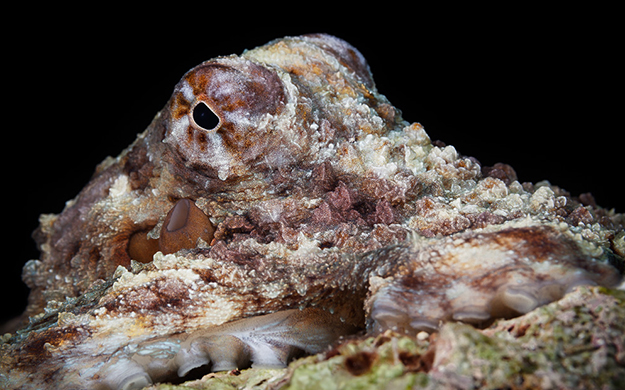Carnival on the Reef
The illusionist
Magicians have nothing on the day octopus, which is the underwater world’s master of “now you see me now you don’t.” In the blink of an eye, these quick-change artists can transform from vivid colors to an enigmatic camouflage that mirrors the patterns of their surroundings.

The day octopus is the underwater equivalent of an illusionist. They can transform in the blink of an eye from vivid colors to that of their surroundings. The day octopus is the underwater equivalent of an illusionist. They can transform in the blink of an eye from vivid colors to that of their surroundings. Photo by Marco Fierli, marcof8.com
The secret is in the tiny spots that cover their skin. These spots are actually pigment sacs that intensify and mute various colors as they are expanded or contracted. In addition to color changes, the day octopus can also alter it’s skin texture from smooth to bumpy, further enhancing it’s illusory appearance.
Send in the clowns
Everybody loves a clown, especially divers and snorkelers. These brilliantly colored little fish are downright delightful to watch and photograph as they perform the seemingly death-defying trick of hiding among the stinging tentacles of an anemone.

More than half of the 25 listed species of anemonefish in the Indo-pacific are found in Wakatobi’s waters. This Spinecheek anemonefish was photographed a few yards from Wakatobi’s jetty. Photo by Terry Crocker
Clownfish, or more appropriately anemonefish, are a subfamily of damselfish, which currently includes twenty-five listed species in the Indo-pacific. Close to half are found in Wakatobi’s waters. Their social group normally consists of one large dominant female, a smaller, sexually active male, a few even smaller males and some juveniles. No clowning around here, when the female dies the dominant male will change sex to take her place over the harem.
Join the carnival
Wakatobi’s reefs are the carnival that never ends and always delivers new possibilities. There’s always one more corner to go around, another ledge to look under, or one last jutting crevice to peek into. These discoveries add an extra dimension to the beauty of the ocean.
Enjoy all that Wakatobi has to offer, above and below the surface. Contact us at office@wakatobi.com or complete a quick trip inquiry at wakatobi.com.
Visit us on Facebook.


